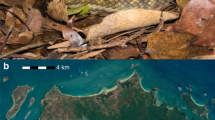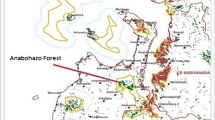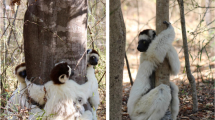Abstract
A 5-month field study was conducted on red-bellied tamarins,Saguinus labiatus labiatus, in the Pando Department of northern Bolivia. Group sizes ranged from 5 to 10 animals, and each group associated with a group of saddle-backed tamarins,Saguinus fuscicollis weddelli. Members of three groups were trapped and marked and data were collected by radiolocation. The average range size used over 10 days was 19 ha. On average the groups entered about 29% of their range each day and had a mean daily path length of about 1487 m. The groups used a number of different sleeping sites within their ranges. They fed on a variety of different fruits and also on nectar from flowers, resin, and insects. Areas within the home range which were used significantly more than expected were generally those in which one or more of the following existed: a sleeping site, an intergroup encounter site, or a site where the group took shelter during an extended period of heavy rain.
Similar content being viewed by others
References
Buchanan-Smith, H. M. (1989a). Inter-group encounters between neighboring groups of tamarins in Bolivia. Paper presented at the Workshop on Callitrichid Behaviour, University of Stirling, June 1989.
Buchanan-Smith, H. M. (1989b).The Social Organization and Mating Systems of the Red Bellied Tamarin (Saguinus labiatus labiatus): Behavioural Observations in Captivity and in the Wild, Unpublished Ph.D. thesis, University of Reading, Reading, U.K.
Buchanan-Smith, H. M. (1990) Polyspecific association of two tamarin speciesSaguinus labiatus andSaguinus fuscicollis in Bolivia.Am. J. Primat. 22: 205–214.
Caine, N. G. (1987). Vigilance, vocalizations and cryptic behavior at retirement in captive groups of red-bellied tamarins (Saguinus labiatus).Am. J. Primatol. 12: 241–250.
Dawson, G. A. (1979). The use of time and space by the Panamanian tamarin,Saguinus oedipus.Folia Primatol. 31: 253–284.
Ferrari, S. F. (1987). Social organisation and behaviour of the marmoset,Callithrix flaviceps.Int. J. Primatol. 8: 492.
Freese, C., Heltne, P., Castro, R. N., and Whitesides, G. (1982). Patterns and determinants of monkey densities in Peru and Bolivia with notes in distributions.Int. J. Primat. 3: 53–90.
Hershkovitz, P. (1977).Living New World Monkeys (Platyrrhini), Vol. 1, University of Chicago Press, Chicago and London.
Hubrecht, R. C. (1984). Field observations on group size and composition of the common mamoset (Callithrix j. jacchus) at Tapacura, Brazil.Primates 25: 13–21.
Hubrecht, R. C. (1985) Home-range size and use and territorial behavior in the common marmoset,Callithrix jacchus jacchus, at the Tapacura field station, Recife, Brazil.Int. J. Primatol. 6: 533–550.
Izawa, K. (1978) A field study of the ecology and behavior of the black mantled tamarin (Saguinus nigricollis).Primates 19: 241–274.
Kleiman, D. G. (1977). Monogamy in mammals.Q. Rev. Biol. 52: 36–69.
Neu, C. W., Byers, C. R., and Peek, J. M. (1974). A technique for analysis of utilization-availability data.J. Wild. Manage. 38: 541–545.
Neyman, P. F. (1977). Aspects of the ecology and social organization of free-ranging cotton top tamarins (Saguinus oedipus) and the conservation status of the species. In Kleiman, D. G. (ed.),The Biology and Conservation of the Callitrichidae, Smithsonian Institution Press, Washington, D.C., pp. 39–71.
Pook, A., and Pook, A. G. (1982). Polyspecific association betweenSaguinus fuscicollis, Saguinus labiatus, Callimico goeldii and other primates in north western Bolivia.Folia Primatol. 38: 196–216.
Rylands, A. B. (1981). Preliminary field observations on the marmosetCallithrix humeralifer intermedius (Hershkovitz) at Dardanelos, Rio Aripuana, Mato Grosso, Brazil.Primates 22: 46–59.
Rylands, A. B. (1986). Ranging behavior and habitat preference of a wild marmoset group,Callithrix humeralifer (Callitrichidae, Primates).J. Zool. Lond. (A) 210: 489–514.
Soini, P. (1982). Ecology and population dynamics of the pygmy marmoset,Cebuella pygmaea.Folia Primat. 39: 1–21.
Soini, P. (1987). Ecology of the saddle back tamarin,Saguinus fuscicollis illigeri on the Rio Pacaya, Northeastern Peru.Folia Primatol. 49: 11–32.
Stevenson, M. F., and Rylands, A. B. (1981) The marmosets, genusCallithrix. In Mittermeier, R. A., and Coimbra-Filho, A. F. (eds.),Ecology and Behaviour of Neotropical Primates, Vol. 2, Academia Brasileira de ciencias, Rio de Janeiro, pp. 131–222.
Sussman, R., and Kinzey, W. (1984). The ecological role of the Callitrichidae: A review.Am. J. Phys. Anthropol. 64: 418–449.
Sussman, R. W., and Garber, P. A. (1987). A new interpretation of the social organization and mating system of the Callitrichidae.Int. J. Primatol. 8: 73–92.
Terborgh, J. (1983).Five New World Primates: A Study of Comparative Ecology, Princeton University Press, Princeton, N.J.
Terborgh, J., and Wilson Goldizen, A. (1985). On the mating system of the cooperatively breeding saddletback tamarin (Saguinus fuscicollis).Behav. Ecol. Sociobiol. 16: 293–299.
Yoneda, M. (1981) Ecological studies ofSaguinus fuscicollis andSaguinus labiatus with reference to habitat segregation and height preference.Kyoto University. Overseas Research Reports of New World Monkeys II, Primate Research Institute, Kyoto University, Inuyama, pp. 43–50.
Yoneda, M. (1984a). Comparative studies on vertical separation, foraging behavior and travelling mode of saddle back tamarins (Saguinus fuscicollis) and red-chested moustached tamarins (Saguinus labiatus) in northern Bolivia.Primates 25: 414–422.
Yoneda, M. (1984b). Ecological study of the saddle back tamarin (Saguinus fuscicollis) in northern Bolivia.Primates 25: 1–12.
Author information
Authors and Affiliations
Rights and permissions
About this article
Cite this article
Buchanan-Smith, H.M. A field study on the red-bellied tamarin,Saguinus l. labiatus, in Bolivia. International Journal of Primatology 12, 259–276 (1991). https://doi.org/10.1007/BF02547587
Received:
Revised:
Issue Date:
DOI: https://doi.org/10.1007/BF02547587




